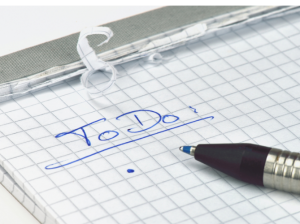Low Motivation and ADHD: Using ‘GRIT’ to tackle the essential tasks when you’re just not interested
 Handling tasks and obligations we don’t enjoy is a part of everyday life. There are always meals to cook, laundry to do and garbage to take out. Most of us need to push ourselves to do tedious chores. Those with ADHD find it especially difficult to get started and follow through on boring, unpleasant tasks. This can lead to frustration, discouragement and even shame. It can also appear as negativity or procrastination. My GRIT method can help adults and kids learn two essential life skills: how to get motivated and how to see the work through to completion. GRIT is a process by which you get yourself ready to do a task or a work project, stay with it, apply consistent effort and finish a part or all of it. Let’s take a closer look.
Handling tasks and obligations we don’t enjoy is a part of everyday life. There are always meals to cook, laundry to do and garbage to take out. Most of us need to push ourselves to do tedious chores. Those with ADHD find it especially difficult to get started and follow through on boring, unpleasant tasks. This can lead to frustration, discouragement and even shame. It can also appear as negativity or procrastination. My GRIT method can help adults and kids learn two essential life skills: how to get motivated and how to see the work through to completion. GRIT is a process by which you get yourself ready to do a task or a work project, stay with it, apply consistent effort and finish a part or all of it. Let’s take a closer look.
People with ADHD lack dopamine, not willpower

The perception that people with ADHD lack grit or willpower is simply not true. ADHD is not a lack of willpower, but rather a condition of being unable to harness the abilities that you have to motivate yourself on something that interests you, and then apply them to something that does not. Dopamine plays an important role here.
People with ADHD are deficient in dopamine, a feel-good neurotransmitter involved in the reward pathway of the brain that can fuel motivation and action. Young people with ADHD, who have also yet to develop strong internal motivation (which usually develops in early adulthood), have an especially tough time feeling any motivation to start or finish day-to-day or long-term tasks and projects.
Grit is the steadfastness and persistence you need to stick with something and complete it. The GRIT method will help you achieve results and enjoy that wonderful sense of accomplishment.
Building Motivation: The What and The Why
In order to build motivation when you have ADHD, it is important to identify what you want to accomplish and why, and set goals accordingly.
Ask yourself:
-
-
- What do I want to achieve?
- Why is this goal important?
-

Here are some examples:
-
-
- I have to pay my bills by the end of the day to avoid late fees.
- I want to do the laundry so I can wear my favorite outfit to work.
-
Similarly, children stand a better chance of finishing unpleasant tasks by setting goals for themselves rather than relying on external motivators:
-
-
- Once I clean my room, I’ll be able to watch a movie.
-
Understanding your goals will not only help motivate you but will make it easier to see the work through to completion. This is an especially important skill for kids and teens to practice as they learn to manage schoolwork and chores independently.
Set Realistic Expectations
Once you’ve identified your goals, create realistic expectations of your capability, available resources and time constraints. Make a plan for when, where and how you’ll get things done. Try breaking large tasks down into smaller, more manageable pieces.
If it’s unrealistic that you’ll wash, dry and fold a load of laundry on a weeknight, split up the work between two nights. Easy tasks can be done anywhere, but difficult tasks might require a quiet room or a stretch of time with minimal interruptions. Consider these constraints and plan accordingly.
Use GRIT to help manage your everyday tasks:
Get situated.

Think about your tasks, do a brain dump and assign numbers to the first 3 items. Then, write where and when you want to do them.
Break your first and second items down into smaller chunks. Finish these first two items before moving on to the next one.
Consider starting your own Personal Project Planner to help you visualize the steps and process of more lengthy or complicated projects.
Resist distraction.
Set reminders. Ask yourself, “How long can I do something before I get bored?” If it’s 20 minutes, do your tasks in 20 minutes. Write yourself a note marking where you left off. Go on your break, set the time, go back to what you were doing. Don’t try to do something for an hour if that’s an unrealistic expectation. It will end in criticism and negative self-talk. We’re all about positive self-talk when building motivation with ADHD.
Implement incentives that matter.
Start with small steps and identify achievable goals. Put the “have-to” before the “want-to,” and use incentives. Watch your TV show after you do the dinner dishes. Meet your friend for coffee after you turn in your project. Use incentives that matter to kids and collaborate with them on setting up the agreement.
Take small steps, and positively talk yourself through the tasks.

Instead of saying to yourself, “Why can’t I get more done? Why didn’t I do this the way it should have been done?” say, “Look at what I was able to do!” Model positivity for your kids.
Try a “high and a low,” or a “happy and a crappy” exercise at dinner to highlight the day’s wins.
Consider writing down three good things or accomplishments each night before bed.
Low motivation is a common struggle for people with ADHD. But you CAN overcome it. Enable yourself with the right motivational tools and a positive can-do attitude. Make it a point to acknowledge each accomplishment, no matter how small.
Read more blog posts:
- Starting Tasks with ADHD: How to help kids and teens feel motivated to get the ball rolling!
- Personal Project Planners for ADHD Minds: Start managing tasks, time and ideas with this creative tool!
- ADHD and Motivation: How stress reduces productivity and what you can do about it
Watch on Dr. Sharon Saline’s YouTube Channel:
-
- What’s my motivation? ADHD & Motivation (ADDitude Mag ADHD Q&A with Psychologist Dr. Sharon Saline)
- Planning and Prioritizing with ADHD (ADDitude Mag ADHD Q&A with Dr. Sharon Saline)
- 4 Tips to Boost Motivation in Kids and Teens (WWLP 22 News Mass Appeal Interview with Dr. Sharon Saline)
Deeper dive: https://drsharonsaline.com/product/harness-grit/ https://drsharonsaline.com/product/home-seminar/
